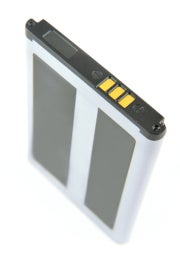Lewis
Member
Part 1 and 2
I Lewis am now using a HTC HD 7 Windows phone and the battery consumption is something else. My Blackberry 9700 does not use the power that my Windows phone does. Also the HTC HD 7 has one f the biggest screens out there, which sucks up more power. I love my HTC Windows 7 phone, but I will keep my Blackberry Bold 9700 always close by.

Why Your Smartphone Battery Will Not Last.
Lithium ion batteries are nearing the limits of their possible power capacity, while the power requirements of mobile devices are increasing quickly. Something’s got to give.
May 18, 2011 9:36 pm
 If you're hoping your next smartphone will run faster, shine brighter, connect at 4G speed, and last longer on one battery charge, you may be in for a rude surprise. The thirst for battery power in new smartphones and tablets is far outpacing improvements in battery technology. Battery makers are trying to wring the last bits of capacity out of 15-year-old lithium ion technology, while device and app makers seem to be just waking up to the seriousness of the problem. There’s an equal share of blame for all parties; meanwhile the immense promise of innovation in mobile devices could come to an early halt due to power limitations, and consumer angst over constantly having to "plug in."
If you're hoping your next smartphone will run faster, shine brighter, connect at 4G speed, and last longer on one battery charge, you may be in for a rude surprise. The thirst for battery power in new smartphones and tablets is far outpacing improvements in battery technology. Battery makers are trying to wring the last bits of capacity out of 15-year-old lithium ion technology, while device and app makers seem to be just waking up to the seriousness of the problem. There’s an equal share of blame for all parties; meanwhile the immense promise of innovation in mobile devices could come to an early halt due to power limitations, and consumer angst over constantly having to "plug in."
Used to be, you could forget your feature phone’s charger at home, go on a long weekend vacation, and--as long as you didn’t play hours of Snake--still come home with enough battery life to call a cab. Today, though, we’re wedded to our chargers, glaring hawkishly at people who’ve been hogging airport and coffee shop outlets for too long.
Switching over to superfast 4G networks, as many will in 2011, is only going to exacerbate the problem, and reports are already in that 4G devices tend to have pitiful battery life. The power requirements of the technology being built into mobile devices are growing at twice the pace of advances in battery capacity, according to one Verizon Wireless executive.
The problem involves the chemical nature of batteries, the system of funding for research and development in the global market for mobile tech, and the many different demands that people are placing on their phones and tablets.
Constrained by Chemistry
Battery technology and smartphone technology are at two very different stages in their lifespans. “Unlike smartphones, battery technology has been evolving for over a century, and is much further down the development curve, meaning that improvements in battery technology, while steady, no longer happen at the breakneck speed of younger technology like smartphones,” says Keith Nowak of phone and tablet maker HTC.
 Smartphone batteries are extremely efficient compared to batteries of a decade ago, but they're reaching a limit.But aside from tiny incremental improvements in solid-electrolyte efficiency, lithium ion polymer batteries for handheld tech products haven't changed drastically in more than 15 years. Almost all of the batteries that power today's smartphones and tablets run on some variant of the lithium ion polymer battery--a cell in which the anode and the cathode are packaged with a solid, gel-like electrolyte (the substance that makes the battery conduct electricity). This solid-electrolyte design was developed commercially in 1996 as manufacturers sought a sturdier battery for mobile tech products. Previously, cell phones had run on lithium ion batteries with liquid electrolytes, which were bulky and relatively unstable.
Smartphone batteries are extremely efficient compared to batteries of a decade ago, but they're reaching a limit.But aside from tiny incremental improvements in solid-electrolyte efficiency, lithium ion polymer batteries for handheld tech products haven't changed drastically in more than 15 years. Almost all of the batteries that power today's smartphones and tablets run on some variant of the lithium ion polymer battery--a cell in which the anode and the cathode are packaged with a solid, gel-like electrolyte (the substance that makes the battery conduct electricity). This solid-electrolyte design was developed commercially in 1996 as manufacturers sought a sturdier battery for mobile tech products. Previously, cell phones had run on lithium ion batteries with liquid electrolytes, which were bulky and relatively unstable.
Today, battery researchers continue to increase the capacity of lithium ion polymer batteries. Since a battery’s power comes from its transfer of electric-charge-bearing electrons between the anode and the cathode, battery researchers focus primarily on optimizing the multitude of mini-transfers. “A lot of chemical reactions can take on a life of their own, and battery scientists try to control that,” said Irving Echavarria of Gold Peak Industries, a company that manufactures all types of consumer batteries, including lithium ion variations. Echavarria estimates that 80 percent of the processes in a battery can be accurately harnessed. And the smaller the battery’s window of errant chemical reactions, the more efficiently the battery will provide power. Battery makers continue to achieve capacity gains by pushing closer to that 80 percent efficiency limit.
But the incremental advances in efficiency aren’t keeping pace with the increasing energy demands of smartphones and other mobile devices. Frustrated by the chemical and physical limits of batteries, developers who want to get longer run times out of smartphone batteries must either add active material to the battery by making the inactive parts of the battery smaller (a technique that has already reached limits of its own) or move from lithium ion polymer to a different, as yet not fully researched material.
Venkat Srinivasan, a battery technology researcher at the Lawrence Berkeley National Laboratory in Berkeley, California, notes that, “the physics that dictates evolution in batteries is different from the physics that dictates evolution in smartphone electronics.” It seems that batteries are doomed to drag along behind the wagon train until a Eureka moment happens occurs with a better material.
I Lewis am now using a HTC HD 7 Windows phone and the battery consumption is something else. My Blackberry 9700 does not use the power that my Windows phone does. Also the HTC HD 7 has one f the biggest screens out there, which sucks up more power. I love my HTC Windows 7 phone, but I will keep my Blackberry Bold 9700 always close by.

Why Your Smartphone Battery Will Not Last.
Lithium ion batteries are nearing the limits of their possible power capacity, while the power requirements of mobile devices are increasing quickly. Something’s got to give.
May 18, 2011 9:36 pm

Used to be, you could forget your feature phone’s charger at home, go on a long weekend vacation, and--as long as you didn’t play hours of Snake--still come home with enough battery life to call a cab. Today, though, we’re wedded to our chargers, glaring hawkishly at people who’ve been hogging airport and coffee shop outlets for too long.
Switching over to superfast 4G networks, as many will in 2011, is only going to exacerbate the problem, and reports are already in that 4G devices tend to have pitiful battery life. The power requirements of the technology being built into mobile devices are growing at twice the pace of advances in battery capacity, according to one Verizon Wireless executive.
The problem involves the chemical nature of batteries, the system of funding for research and development in the global market for mobile tech, and the many different demands that people are placing on their phones and tablets.
Constrained by Chemistry
Battery technology and smartphone technology are at two very different stages in their lifespans. “Unlike smartphones, battery technology has been evolving for over a century, and is much further down the development curve, meaning that improvements in battery technology, while steady, no longer happen at the breakneck speed of younger technology like smartphones,” says Keith Nowak of phone and tablet maker HTC.

Today, battery researchers continue to increase the capacity of lithium ion polymer batteries. Since a battery’s power comes from its transfer of electric-charge-bearing electrons between the anode and the cathode, battery researchers focus primarily on optimizing the multitude of mini-transfers. “A lot of chemical reactions can take on a life of their own, and battery scientists try to control that,” said Irving Echavarria of Gold Peak Industries, a company that manufactures all types of consumer batteries, including lithium ion variations. Echavarria estimates that 80 percent of the processes in a battery can be accurately harnessed. And the smaller the battery’s window of errant chemical reactions, the more efficiently the battery will provide power. Battery makers continue to achieve capacity gains by pushing closer to that 80 percent efficiency limit.
But the incremental advances in efficiency aren’t keeping pace with the increasing energy demands of smartphones and other mobile devices. Frustrated by the chemical and physical limits of batteries, developers who want to get longer run times out of smartphone batteries must either add active material to the battery by making the inactive parts of the battery smaller (a technique that has already reached limits of its own) or move from lithium ion polymer to a different, as yet not fully researched material.
Venkat Srinivasan, a battery technology researcher at the Lawrence Berkeley National Laboratory in Berkeley, California, notes that, “the physics that dictates evolution in batteries is different from the physics that dictates evolution in smartphone electronics.” It seems that batteries are doomed to drag along behind the wagon train until a Eureka moment happens occurs with a better material.
Last edited by a moderator:








 :
: